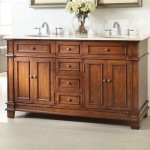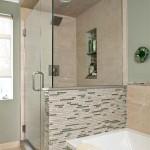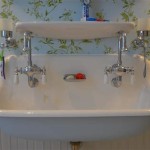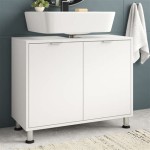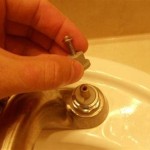Slim Short Bathroom Cabinets: Optimizing Space and Style
Bathrooms, particularly in apartments and older homes, often present spatial challenges. A common issue is the limited square footage available for storage, forcing homeowners to compromise between functionality and aesthetics. Slim, short bathroom cabinets offer a practical solution to this problem, providing ample storage without overwhelming the room or obstructing pathways. These cabinets are designed to fit into narrow spaces and low areas, maximizing otherwise unusable areas within the bathroom.
The term "slim" refers to the cabinet's depth, typically less than the depth of standard cabinets. This reduced depth allows for installation in tight areas, such as alcoves or between fixtures. "Short" denotes the height of the cabinet, making it suitable for placement under sinks, below windows, or in areas with limited vertical clearance. Combining these two features creates a highly adaptable storage solution for bathrooms of various sizes and configurations. The variety of materials, styles, and finishes available further enhances their versatility, allowing integration into diverse bathroom design themes.
Factors to Consider When Selecting a Slim Short Bathroom Cabinet
Choosing the right slim short bathroom cabinet involves careful consideration of several key factors. These include determining storage needs, evaluating available space, selecting appropriate materials, and choosing a style that complements the existing bathroom decor. A thorough assessment of these aspects ensures that the chosen cabinet effectively addresses the specific requirements of the bathroom and its user.
Storage Needs: The primary function of a bathroom cabinet is to provide storage. Before selecting a cabinet, it is crucial to assess the specific storage needs of the household. This involves identifying the items that require storage, such as toiletries, towels, cleaning supplies, and medications. Consider the quantity and size of these items to determine the required capacity of the cabinet. Drawers are useful for organizing smaller items, while shelves are better suited for larger items like towels or shampoo bottles. Cabinets with a combination of drawers and shelves often offer the most versatile storage options.
Furthermore, consider the specific storage requirements of different users. For example, a family bathroom may require more spacious storage for children's toiletries and bath toys. A guest bathroom, on the other hand, may require less storage space. By carefully assessing the specific storage needs, it is possible to select a cabinet that effectively organizes and accommodates all necessary items, minimizing clutter and maximizing functionality.
Space Evaluation: After determining storage needs, the next step is to thoroughly evaluate the available space in the bathroom. Measure the width, depth, and height of the area where the cabinet is intended to be placed. Pay close attention to any obstructions, such as pipes, electrical outlets, or architectural features. It is important to ensure that the cabinet will fit comfortably within the designated space without impeding movement or access to other fixtures.
Consider the clearance required for opening doors and drawers. A cabinet with hinged doors may require more space than a cabinet with sliding doors or drawers. If space is limited, a wall-mounted cabinet may be a better option than a floor-standing cabinet, as it frees up floor space and creates a more open and airy feel. Similarly, corner cabinets are designed to fit into tight corners, maximizing otherwise unused space. Accurate measurements and careful consideration of these factors are essential for selecting a cabinet that fits perfectly within the available space and functions optimally.
Material Selection: The choice of material significantly impacts the durability, aesthetics, and maintenance requirements of the bathroom cabinet. Common materials used for bathroom cabinets include wood, MDF (Medium-Density Fiberboard), particleboard, metal, and plastic. Each material has its own advantages and disadvantages, and the best choice depends on the specific needs and preferences of the homeowner.
Wood cabinets are known for their natural beauty and durability. They are available in a wide variety of finishes and styles, but they can be more expensive than other materials. Solid wood is resistant to moisture damage, but it can warp or crack if exposed to excessive humidity. MDF is a more affordable alternative to solid wood. It is a stable and durable material that is resistant to warping and cracking. However, it is not as resistant to moisture damage as solid wood, so it is important to choose an MDF cabinet with a moisture-resistant finish.
Particleboard is the least expensive option, but it is also the least durable. It is susceptible to moisture damage and can easily warp or crack. Metal cabinets are known for their durability and resistance to moisture damage. They are often used in modern or industrial-style bathrooms. Plastic cabinets are lightweight and easy to clean. They are also resistant to moisture damage, making them a good choice for humid environments.
Style and Finish: The style and finish of the bathroom cabinet should complement the existing bathroom decor. Consider the overall design theme of the bathroom, such as traditional, modern, contemporary, or rustic. Choose a cabinet that aligns with this theme and enhances the overall aesthetic appeal of the space. The finish of the cabinet should also be durable and easy to clean. Common finishes include paint, stain, lacquer, and laminate.
Paint is a versatile finish that can be used to create a wide range of looks. It is available in a variety of colors and sheens, allowing for customization to match the existing decor. Stain is a transparent finish that enhances the natural beauty of the wood grain. It is available in a variety of shades, from light to dark. Lacquer is a durable and glossy finish that is often used on high-end cabinets. Laminate is a synthetic finish that is resistant to scratches and stains. It is available in a variety of colors and patterns, making it a cost-effective alternative to wood.
Benefits of Using Slim Short Bathroom Cabinets
Slim, short bathroom cabinets offer numerous advantages, particularly in smaller bathrooms. These benefits extend beyond simple storage, encompassing space optimization, improved organization, and enhanced aesthetic appeal. The efficient use of space allows for increased functionality without sacrificing the overall comfort and design of the bathroom.
Space Optimization: The primary benefit of slim short bathroom cabinets is their ability to optimize space in small bathrooms. Their narrow depth allows them to fit into tight areas, such as between the toilet and the wall or under the sink. Their short height makes them ideal for placement under windows or in areas with limited vertical clearance. By utilizing these otherwise unusable spaces, slim short bathroom cabinets maximize storage capacity without taking up valuable floor space.
This space optimization is particularly beneficial in apartments and older homes where bathroom space is often limited. By installing a slim short bathroom cabinet, homeowners can create a more functional and organized bathroom without having to undergo costly renovations. Furthermore, the reduced footprint of these cabinets helps to create a more open and airy feel, making the bathroom feel larger and more comfortable.
Improved Organization: Slim short bathroom cabinets provide a dedicated space for storing toiletries, towels, and other bathroom essentials. This helps to declutter the countertop and other surfaces, creating a more organized and visually appealing bathroom. The presence of drawers and shelves allows for efficient sorting and categorization of items, making it easier to find what is needed. This improved organization not only enhances the functionality of the bathroom but also reduces stress and saves time.
Many slim short bathroom cabinets come with adjustable shelves, allowing for customization to accommodate items of different sizes. This further enhances the organization and efficiency of the cabinet. The ability to store items neatly and out of sight also helps to protect them from dust and moisture, prolonging their lifespan.
Enhanced Aesthetic Appeal: Slim short bathroom cabinets are available in a wide variety of styles and finishes, allowing homeowners to choose a cabinet that complements the existing bathroom decor. They can be used to add a touch of elegance, modernity, or rustic charm to the bathroom. The presence of a well-designed and well-organized cabinet can significantly enhance the overall aesthetic appeal of the space.
Wall-mounted cabinets can create a more contemporary and minimalist look, while floor-standing cabinets can provide a more traditional and substantial feel. The choice of hardware, such as knobs and pulls, can also contribute to the overall aesthetic appeal of the cabinet. By carefully selecting a cabinet that complements the existing decor, homeowners can create a bathroom that is both functional and visually appealing.
Installation and Maintenance Tips
Proper installation and regular maintenance are crucial for ensuring the longevity and optimal performance of slim short bathroom cabinets. Incorrect installation can lead to instability, damage, and reduced functionality. Regular maintenance, such as cleaning and tightening hardware, can prevent wear and tear and prolong the life of the cabinet.
Installation Procedures: The installation procedure for a slim short bathroom cabinet depends on the type of cabinet, such as floor-standing or wall-mounted. Floor-standing cabinets typically require minimal installation, often involving only the attachment of legs or feet. Wall-mounted cabinets, on the other hand, require more complex installation, involving the secure attachment of the cabinet to the wall studs.
Before installing a wall-mounted cabinet, it is essential to locate the wall studs using a stud finder. The cabinet must be securely attached to the studs to ensure stability and prevent it from falling down. Use appropriate screws and anchors to ensure a secure connection. If unsure about the installation process, it is advisable to hire a professional installer to avoid damaging the cabinet or the wall.
Cleaning and Maintenance: Regular cleaning is essential for maintaining the appearance and hygiene of the bathroom cabinet. Use a mild soap and water solution to clean the cabinet surfaces. Avoid using harsh chemicals or abrasive cleaners, as these can damage the finish. Wipe the cabinet dry after cleaning to prevent water stains and moisture damage.
Periodically inspect the cabinet for any signs of damage, such as scratches, dents, or loose hardware. Tighten any loose screws or hinges to prevent further damage. If the cabinet has drawers, lubricate the drawer slides regularly to ensure smooth operation. Apply a furniture polish to wooden cabinets to protect the finish and enhance their appearance. By following these simple maintenance tips, you can prolong the life of your slim short bathroom cabinet and keep it looking its best.

Kleankin Short Bathroom Storage Cabinet Organizer With 1 Drawer And Adjustable Shelf For Living Room White Com

Homcom Slim Floor Cabinet Narrow Wooden Storage With Drawers Bathroom White Diy At B Q

Slim Bathroom Storage Cabinet Narrow Stand Black Aojezor Com

Kleankin Slim Bathroom Cabinet With Castor Wheels Storage Organizer And Wood Shelves To Fit In Small Spaces White

Wireworks Slim Bathroom Cabinet With Mirror Short Heal S

Nice Short Long Storage Cabinet Arts Lovely Or Narrow Design Home Interiors Decor F

Kleankin Slim Bathroom Cabinet With Castor Wheels Storage Organizer And Wood Shelves To Fit In Small Spaces White

Wireworks Slimline Cabinet Heal S

15 Small Bathroom Vanity Ideas That Rock Style And Storage

Homcom 6 X 20 5 26 Wood Rolling Narrow Bathroom Side Storage Cabinet White Target
Related Posts

